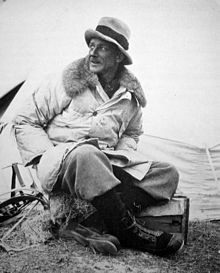George Finch (chemist)
| George Finch | |
|---|---|
 |
|
| Native name | George Ingle Finch |
| Born | 4 August 1888 |
| Died | 22 November 1970 (aged 82) |
| Fields |
Chemical Physics Electrochemistry |
| Institutions | Imperial College London |
| Alma mater | University of Geneva |
| Known for | British Mount Everest Expedition 1922 |
| Notable awards |
Fellow of the Royal Society Hughes Medal (1944) |
George Ingle Finch MBE FRS (4 August 1888 – 22 November 1970) was an Australian chemist and mountaineer.
He was born in Australia but educated in German-speaking Switzerland and studied physical sciences at University of Geneva.
During the First World War, he served with the Royal Army Ordnance Corps. He was appointed a Member of the Order of the British Empire in the 1918 New Year Honours for services in connection with the War in France, Egypt and Salonika.
A member of the second British expedition under General Charles Granville Bruce to Mount Everest, on 23 May 1922 Finch and Captain Geoffrey Bruce reached an elevation of 27,300 feet (8,321 m) on the north ridge before retreating. Finch fell out with the Everest Committee after 1922, but his pioneering work on oxygen, which he pursued with messianic zeal, remained crucial to future expeditions. In the Alps, Finch was on the first ascent of the North Face Diagonal or "Finch Route" on the Dent d'Hérens, which he climbed with T. G. B. Forster and R. Peto on 2 August 1923. Finch was also a keen skier and was a founding members of the Alpine Ski Club in 1908. He was a lifelong advocate and supporter of the Alpine Club and would later become its president.
Between 1936 and 1952 he held the position of Professor of Applied Physical Chemistry at Imperial College London.
He was elected a Fellow of the Royal Society in 1938. His candidacy citation read
...
Wikipedia
